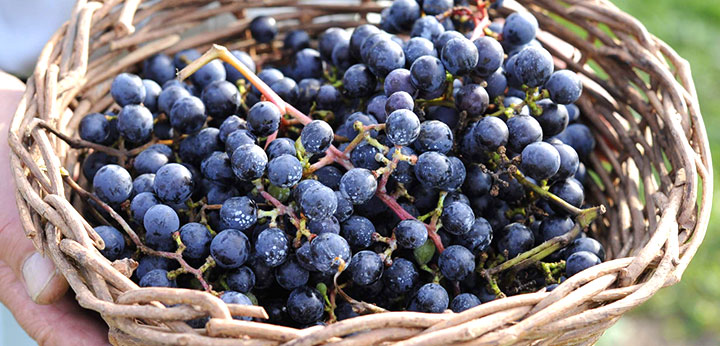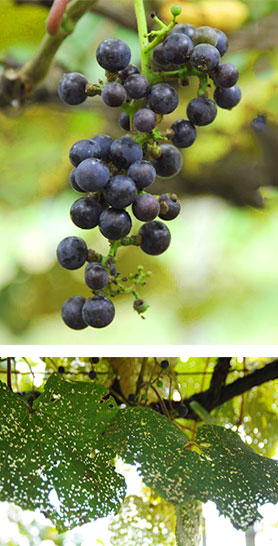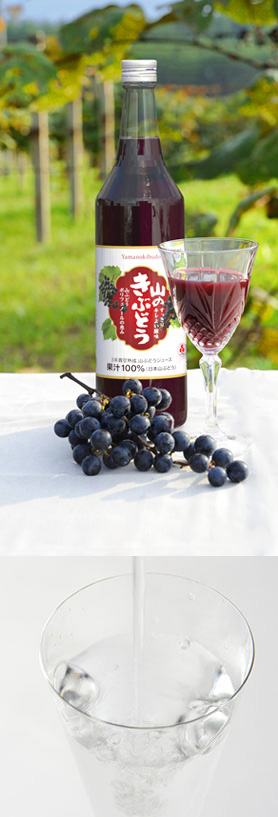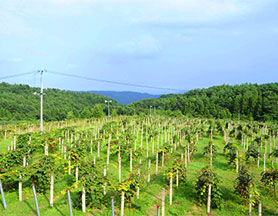▶ About Crimson glory vine
▶ Our Principles
▶ About Sakohonten
▶ About Company Vineyard
▶ How to Enjoy

Grown in the land of a severe climatic environment of the northern part of the Tohoku region, Crimson glory vine has long been valued as “Japan’s native super fruit” by the Japanese people.
What is Crimson glory vine?
A rare grape species native to Japan
The botanical name of Crimson glory vine is Vitis coignetiae. The name Crimson glory vine first appeared in Kojiki (A.D. 712), the oldest history book in Japan. Today we can enjoy many varieties and species of grapes, almost all of which originally came from Europe or America. Crimson glory vine is one of the only two Japanese native species of grape vines. The other is “Koshu.”
Having a root in wild grapes grown under severe natural environment
Crimson glory vine, which is officially called Nihon Yamabudo in Japanese, is grown wild in mountains. Basically its habitat is distributed only in Japan, mainly in mountainous areas in Hokkaido and Honshu (the main island). It has been regarded as a nutritious fruit which Asiatic black bears or brown bears would eat before going into hibernation.
Treasure grape with high rarity
Compared with other species, an individual grape berry is small in diameter (8 mm) but it contains large seeds. Consequently the amount of juice from a berry is very small. It takes 6 years, 3 times as long as regular grapes, to become a ripe berry. Crimson glory vine is hard to bear a fruit because it has males and females. Crimson glory vine, currently being widely grown in Japan, still retains its value of rarity.

Power of Crimson glory vine
Easily consumable
Crimson glory vine is not suitable to be eaten raw because of its wildly bitter and sour taste. Yet the vine has been well known to have potential medical properties and thus been used as medicinal beverage for a long time. In addition to the pharmaceutical benefit, its tree bark is used for weaving baskets and vine sap is recently used as cosmetic ingredient. Crimson glory vine is a fruit tree that has been utilized for people’s everyday lives.
Filled with excellent nutrients
Grapes generally have a large amount of polyphenol. Crimson glory vine contains 8 times as much polyphenol as other grapes. Its outstanding characteristic is a large amount of procyanidin, a strong antioxidant agent. In addition, the amounts of iron, calcium and potassium are 3 to 7 times as much as regular grapes. A tiny berry of Crimson glory vine is filled with essential nutrients we need.
Excellent nutrients of Crimson glory vine
(compared with regular grapes)
Source: Official Yamabudou [sic] website of the Iwate Prefectural Regional Development Bureau in Kuji
Vine Sap has drawn much attention as a new agent for healthy skin
Consisting of moisture and other nutrients sucked up from the soil, sap is fluid transported in tubes and cells through the vine. Crimson glory vine sap is thus regarded as “the source of nutrients essential to promote healthy budburst and growth.” The sap contains saccharides, organic acids like malic acid, and amino acids such as glutamine and asparagine. These components are said to work effectively as skin moisturizers and cell activators.
Polyphenol:
8 times
Potassium:
3 times
Calcium:
7 times
β-carotene:
10 times
Dietary fiber: 7 times
Vitamin E:
10 times
Iron:
3 times
Vitamin C:
4 times

Crimson glory vine and Kuji
Closely related to Crimson glory vine
According to legend, people in the doctorless Kuji area have made an alcoholic beverage from Crimson glory vine and used it as a traditional family remedy in the past 700 years. It is to drink straight as nutritious tonic for adults and to dilute with water and put sugar as cold remedy for children. In Kuji-shi, there is an area called Hashikami, Yamane-cho. Hashikami is a word that means “a place where Crimson glory vines grow” in the Ainu language. It shows the Kuji area is deeply related to Crimson glory vine.
Amulet for expectant mothers
Crimson glory vine, once it was known to contain abundant amount of iron, expectant and nursing mothers have made good use of it before and after childbirth. Home birth with the help of midwife was a matter of course at that time. Nourishing Crimson glory vine is thus essential to expecting mothers in the area. People in the Kuji area have shared a trust in the beneficial aspects of Crimson glory vine for their health and beauty.
The Japan’s No.1 Crimson glory vine producing land
In 1971, the company launched the sales of “Yama-no-Kibudo,” the Japan’s first 100% pure additive-free straight juice from Crimson glory vine. The company’s vineyard was opened in the same year. It was the moment when the history of Crimson glory vine cultivation in Japan started. The growing areas spread out around Japan, mainly in the Tohoku region. Iwate prefecture produces more Crimson glory vine than any other prefectures. The harvest in the Kuji area accounts for 40% of total crops in Iwate. Kuji is literally “the Japan’s No.1 Crimson glory vine producing land.”

Sakohonten Co., Ltd.
Products
Beverage Products
Cosmetic Raw Materials
About Us
Copyright © 2023 Sakohonten Co., Ltd. All rights reserved.
